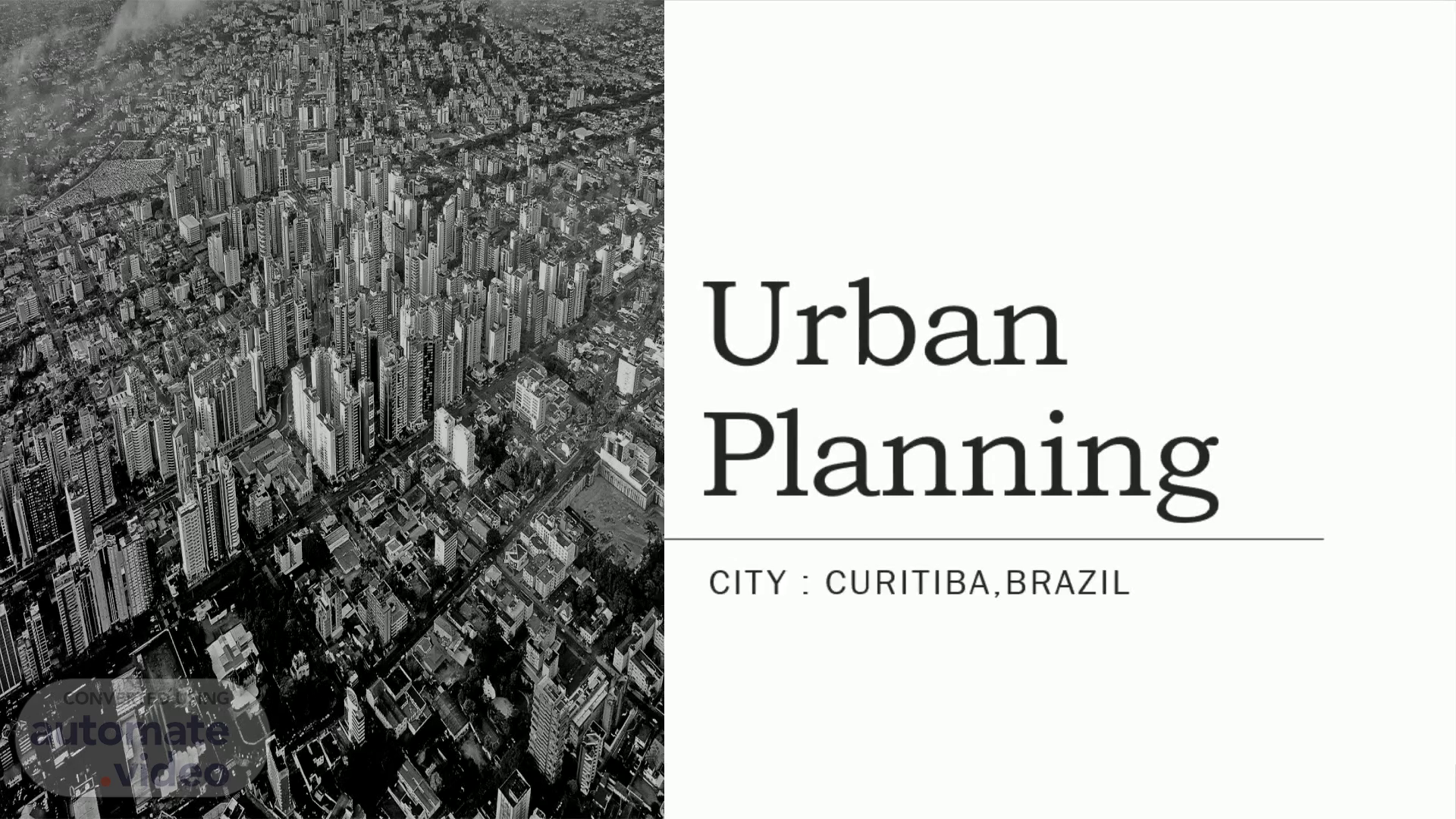Scene 1 (0s)
[Audio] Curitiba, Brazil. Urban Planning. CITY : Curitiba,Brazil.
Scene 2 (7s)
[Audio] This presentation looks at the history , city context and urban planning features of the city - Curitiba.
Scene 3 (19s)
[Audio] Curitiba city, capital of Paraná estado ( state), southern Brazil is known as a cultural center & home to a number of performance venues, including the Wire Opera House and the huge Teatro Guaíra, with diverse programs..
Scene 4 (41s)
[Audio] Curitiba was founded in 1654 as a gold-mining camp, but the processing of tea and wood products brought long-term growth. In 1854 Curitiba became the state capital. From the early 19th century it received many German, Italian, and Polish settlers. From the early 1970s the city underwent extensive rejuvenation, which included the creation of new lakes and flood-control systems, large parks, and other recreational facilities. It also introduced recycling programs, zoning regulations, and specialized busing services that made it a model of clean environmental urban planning. Most of this development was under the direction of Jaime Lerner, an architect and engineer who held three terms as mayor of the city and two terms as governor of the state..
Scene 5 (1m 33s)
[Audio] Curitiba has suffered from all the typical problems brought by rapid urban growth: mass unemployment, transport congestion, lack of basic services and uncontrolled growth of squatter settlements..
Scene 6 (1m 52s)
[Audio] Curitiba was the processing and distribution center for the surrounding agricultural industry. After a series of frosts between 1952 and 1975 sent the industry into a downward spiral, workers began turning to Curitiba in search of employment. During this time Curitiba "was characterized by a shortage of electricity, telephones, and paved streets. Traffic was beginning to become more of a problem in the downtown area." In response to the influx of people, the mayor of Curitiba initiated a Master Plan design competition for the growing capital city. The winning team consisted of young idealistic planners and architects lead by Jaime Lerner..
Scene 7 (2m 37s)
Urban Planning. 26 cities With more than 10 Million inhabitants (t»gures private developped by cities more than mnæntrations of more than 1 Millim inhabitants envisaged in 2010 trom 1996) AFFECTING phys cal Ixatvon of EMPLOYMENT 8 FOR SOLVING PROBLEMS industry Ømrnerce human interraction patern.
Scene 8 (2m 48s)
[Audio] Urban planning solutions by Jaime Lerner prefers : Public transport , working with environment & citizen participation instead of private vehicles , against the environment and master planning ..
Scene 9 (3m 2s)
[Audio] Urban planning features in Curitiba includes : Controlling the flooding.
Scene 10 (3m 18s)
[Audio] Priority to public transport. Urban Planning.
Scene 11 (3m 42s)
[Audio] Participation through incentives. Urban Planning.
Scene 12 (3m 54s)
[Audio] Bilan in Curitiba. Urban Planning. BILAN IN CURITIBA o INTERCONNECTED SOLUTIONS prefé*ig public o transrvt. rating bl$.cle and path in the urban nvolving the e as pssible Cræting ffn a psitve attitude and raducim the I irngzct Transforming problems as potentials generators of new ressources.
Scene 13 (4m 5s)
[Audio] Urban planning process in Curitiba occurred in 3 segments : 1943 – first master plan , 1965 to 1966 – new master plan and 2004 revision of the master plan ..
Scene 14 (4m 21s)
[Audio] After Master Plan for Curitiba was adopted in 1968, Brazilian Curitiba city has implemented several innovative systems to create jobs, improve public transportation accessibility, promote housing development, and improve waste management. The city has implemented several innovative systems to create jobs, improve public transportation accessibility, promote housing development, and improve waste management. Curitiba has initiated a Bus Rapid Transit System and established the Curitiba Industrial City ( CIC) on the city's west side which has strict environmental regulations and does not allow "polluting" industries..
Scene 15 (5m 2s)
[Audio] Benefits of the planned city includes Reduced transportation time , creating more job opportunities , lower fuel usage , Improved outdoor air quality and associated health benefits , recycling of solid wastes and reduced food mitigation expenditures..
Scene 16 (5m 36s)
[Audio] The map shows the proposed master plan of Curitiba in the future..
Scene 17 (5m 47s)
[Audio] Major components of the master plan includes : Connective corridors ,.
Scene 18 (6m 18s)
[Audio] Anchors: large parks, patches, & preserves , Land reclamation and water recuperation and parklands..
Scene 19 (6m 45s)
[Audio] Curitiba has a long tradition of innovative and integrated urban planning geared toward the strategic imperative of making the city a better place to live, as outlined in the city's Master Plan of 1965. From the 1990s until today, the city's main planning focus has been on sustainable development and integration of Curitiba's metropolitan region. Strong political leadership and continuity has been essential to long-term implementation of the city's plan. The city maximizes the efficiency and productivity of transportation, land-use planning and housing development by integrating them so they support one another to improve the quality of life in the city. Although , Curitiba is known internationally as a sustainable, ecological city, it calls itself "the city of all of us.".
Scene 20 (7m 36s)
[Audio] Thank you .. Thank you. RESHMA S I RONALD FRANK.
